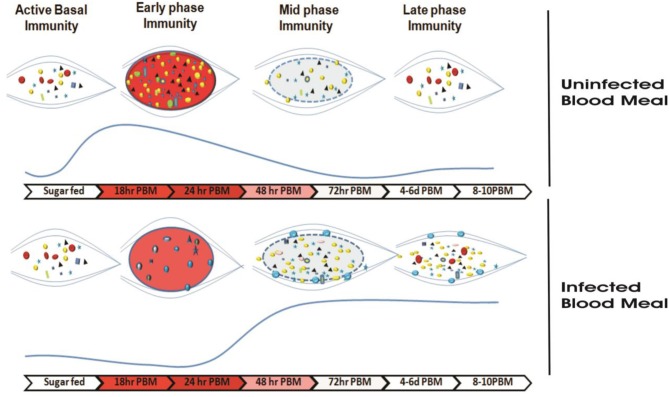Figure 9.
Survival strategy model of P. vivax during the pre-invasive phase of development inside the mosquito gut: A schematic representation of the microbial distribution in response to blood-feeding vs. Plasmodium-infected blood meal. In absence of Plasmodium, after a normal blood-feeding rapid proliferation of gut bacteria occurs in a nutrient-rich medium (of which Fe is indispensable to bacterial growth) during a time window of 18–24 h. Mosquito induces an innate immune response (via the production of various AMPs) to this incremental bacterial growth in order to tame the bacterial load and restore it to a basal level by 48 h. In presence of Plasmodium, Plasmodium vivax suppresses the proliferation of the gut bacteria possibly by altering Fe metabolism or nutrition physiology during initial hours (18–24 h) in a bid to dampen the mosquito innate immune response and to shore up ookinete invasion. In a direct competition for nutritional resources within the gut lumen between the parasite and bacteria, the parasite overcomes the bacteria. The parasite leaves the lumen and encysts beneath the basal lamina. After 48 h post-blood meal, in absence of competition with the parasite in the gut lumen allows the bacteria to proliferate possibly by feeding on undigested food left in the lumen. As the bacterial load rises, it leads to activation of mosquito innate immune responses followed by synthesis of various AMPs which not only limit the bacterial load but also limit the medium and late oocyst development.  ,
,  ,
,  ,
,  ,
,  ,
,  , different bacteria residing the gut;
, different bacteria residing the gut;  , Elizabethkingia,
, Elizabethkingia,  , Pseudomonas,
, Pseudomonas,  , Serratia;
, Serratia;  , Plasmodium viva;
, Plasmodium viva;
 , midgut;
, midgut;  , blood bolus after normal blood-feeding,
, blood bolus after normal blood-feeding,  , blood bolus after Plasmodium-infected blood uptake;
, blood bolus after Plasmodium-infected blood uptake;  , peritrophic matrix after blood digestion.
, peritrophic matrix after blood digestion.

